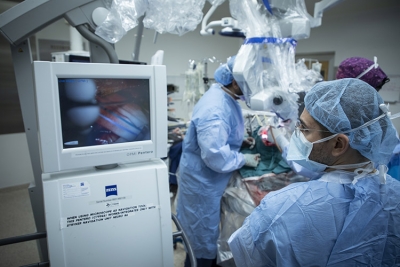It’s called “the great mimic”: pheochromocytoma, a rare tumour with symptoms that can look like high blood pressure, low blood sugar, thyroid problems, or even panic attacks. These were some of the symptoms experienced by patient Bryde Fresque. Read his incredible story.
The Ottawa Hospital is on the leading edge of research and treatment of pheochromocytoma thanks to many experts on the subject.
Often called “pheo” for short, many cases of pheochromocytoma go undiagnosed because the symptoms — high blood pressure, fast heart rate, and sweating — are episodic, meaning they come and go in what might seem like “attacks” or “spells.”
The symptoms are caused by pheochromocytomas usuallyforming on one of the body’s adrenal glands, causing an excess of adrenaline. Patients’ stories can be quite dramatic — with young, otherwise healthy people suffering mysterious symptoms or sudden heart failure.
DID YOU KNOW? A famous example of an undiagnosed pheochromocytoma is President Dwight D. Eisenhower. After his death, it was found he had a pheochromocytoma that may have contributed to his high blood pressure.
How rare are pheochromocytomas?
The incidence of pheochromocytoma is between one or two cases out of every 100,000 people. They occur about equally among the sexes, and can happen at any age, but are most common between 30 and 50. Most occur for random or unknown reasons; around one third of cases are due to a hereditary genetic cause.
How are pheochromocytomas diagnosed?
Doctors look for pheochromocytoma when otherwise healthy patients appear with symptoms that don’t have other explanations. If pheochromocytoma is suspected, a doctor will order lab tests of urine and blood to check hormone levels and use CT imaging scans to see if there’s a tumour.
How are pheochromocytomas treated?

Pheochromocytomas are usually treated by surgically removing the entire adrenal gland. The surgery can be dangerous because it stimulates the tumour, which can cause an increase in blood pressure during surgery. To prevent this, doctors, endocrinologists, and anesthesiologists work together to keep blood pressure levels low before and during surgery.

“After the surgery, they gave me my diagnosis – a reason for my previous symptoms. I had a pheochromocytoma, which is a rare form of tumour that can be cancerous.”
— Bryde Fresque
Are pheochromocytomas cancer?
Pheochromocytomas canbe cancerous, but most aren’t; only about 10% of pheochromocytomas spread to other parts of the body. Either way, removal is recommended due to the risk they pose. The effects of an untreated pheochromocytoma can be heart failure, stroke, and kidney failure.
If the pheochromocytoma is cancerous, other treatments can include radiation, chemotherapy, and/or targeted cancer therapies that inhibit further growth and spread.
What’s the future of pheochromocytomas?
Currently, most of the research into pheochromocytoma focuses on the genetic causes behind it; there are several genes known to be involved in their development. Researchers hope to be able to detect pheochromocytomas earlier, identify people at risk of developing them, and improve their understanding of why they form and how to treat them.
The Ottawa Hospital is not only a leader when it comes to treating pheochromocytomas, but also when it comes to donor-supported research into rare diseases like “pheo” adrenal tumours. The combination makes for world-class care, right here in Ottawa.

